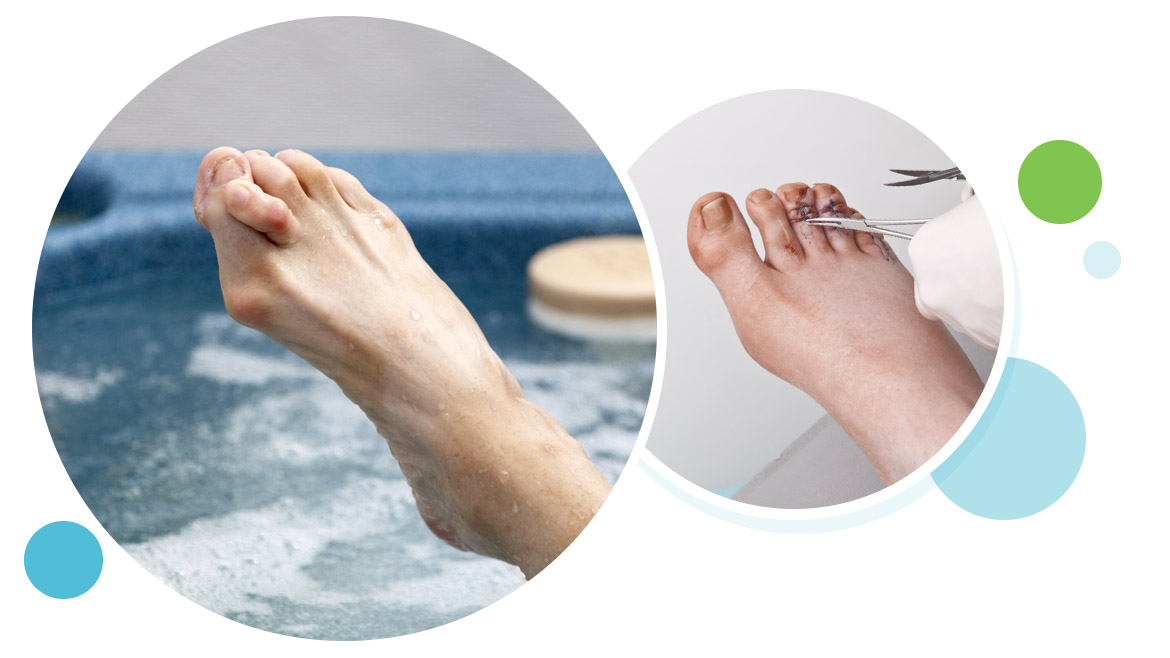Hammertoes
A bending deformity of one or both joints located in the second through fifth toes, the abnormal bending of this condition can lead to putting pressure on the toes when shoes are being worn. While it can be present at birth, the condition usually develops because of poor-fitting shoes that are tight or that have pointed heels. Usually starting as mild deformities then worsening over time, if left untreated they can become much more rigid and non-responsive to treatment. Since it is a progressive condition, it needs immediate attention. The condition has variations including mallet toes, and claw toes. Knowing which variation you may be experiencing will help tailor your treatment plan. This condition will not improve without medical care, but is usually very treatable.
Hammertoe Causes
Usually, hammertoe results from tendon and muscle imbalances. The pathomechanics that cause hammertoe deformities is caused by one of the three; the need to help stabilize the arch of the foot, possible assistance in lifting the foot up during gait, possible helping the foot push-off during gait. In some cases, the imbalance can be caused by neurological or structural changes in the foot such as tightened ligaments and tendons, an unusually high arch or a genetic predisposition. Occupational causes include wearing shoes that fit improperly and crowd the toes. Trauma to the foot that does not correctly heal could result in progressive hammertoe conditions. Pressure from a bunion because of your big toe pointing in toward your second toe can also lead to hammertoe. As a progressive foot condition, it often increases in significance until it requires treatment.
Symptoms
Hammertoes can lead to a variety of symptoms. Some of the more common symptoms suffered from the condition include:
- Contracture of the joints
- Inability or difficulty wiggling toes
- Toes that are claw-like
- Toe bending downward
- Problems walking
- Calluses or corns on the ball of the foot, between toes, or on the toes caused by the constant friction of the skin in the shoe
- Redness, burning sensations, or inflammation
- Irritation or pain of the affected toes when wearing shoes
- Open sores might form in more serious cases
Diagnosis
While hammertoes are apparent from a visual examination of your foot, your doctor will get a thorough medical history and ask about your symptoms before performing a physical examination of your foot. The doctor might try to reproduce the symptoms you suffer by studying the toes’ contracture and through manipulation of your foot. X-ray will be used to assess the structural condition of the small joints in the foot and toes. After the doctor has thoroughly examined your foot and confirmed the diagnosis, a treatment plan will be created to match your specific needs.
Treatment
You will need to have your hammertoe examined by a physician. The treatment your doctor recommends is dependent on your condition’s severity and several other factors. Here are some of the non-surgical approaches to tackling the condition:
Non-surgical Treatments for Hammertoe
- Changing shoes – Your doctor will recommend that you change the kinds of shoes you wear. Don’t wear shoes that are too short, high heels, or shoes that have pointed toes. You shouldn’t wear shoes that put your foot in a situation where your toes might be pressed against the shoe’s front. Wear shoes that are comfortable and have roomy toe areas. Don’t wear anything taller than two-inch heels.
- Corn and callus padding – Pads that are made to keep corns from becoming irritated can be prescribed by your doctor. If the over-the-counter pads don’t work, your physician can prescribe some for you.
- Orthotic devices – Your shoe might need a custom-made orthotic device that could help with any tendon or muscle imbalance.
- Medications – Ibuprofen or other non-steroidal anti-inflammatory (NSAIDs) oral medications might be beneficial since they can reduce inflammation and pain.
- Splinting – Small straps or splints might be used to help straighten or realign the toe.
Hammertoe Surgeries
Sometimes surgery might be beneficial, especially if you have other foot issues, such as bunions that need to be corrected. The number of toes involved, the severity of your foot deformity, your activity level, your medical condition, your age, and several other factors are considered when the doctor determines if surgery will work best for you. Surgical intervention may differ depending on whether the toe is fixed or if it is still in a flexible state. Your podiatrist at Northstate Foot & Ankle Associates will take measures to tailor your specific hammertoe procedure based on the pathology present.
Recovery
Your recovery period depends on the procedures that you undergo. If the surgery requires pins to straighten the toe, it will be about one month before the pins can be removed. Utilizing a brace or and physical therapy will be recommended to ensure proper healing. While complete usage can be resumed in a few months, there may be swelling that occurs for up to the first year.
With the proper treatment, hammertoe will most likely go away without any further complications. Putting off treatment for your hammertoe might cause deformities in your other toes as they are forced out of position. You should get a treatment plan underway as soon as possible, so your condition doesn’t worsen and so that you have the best chance of recovery without surgery.

